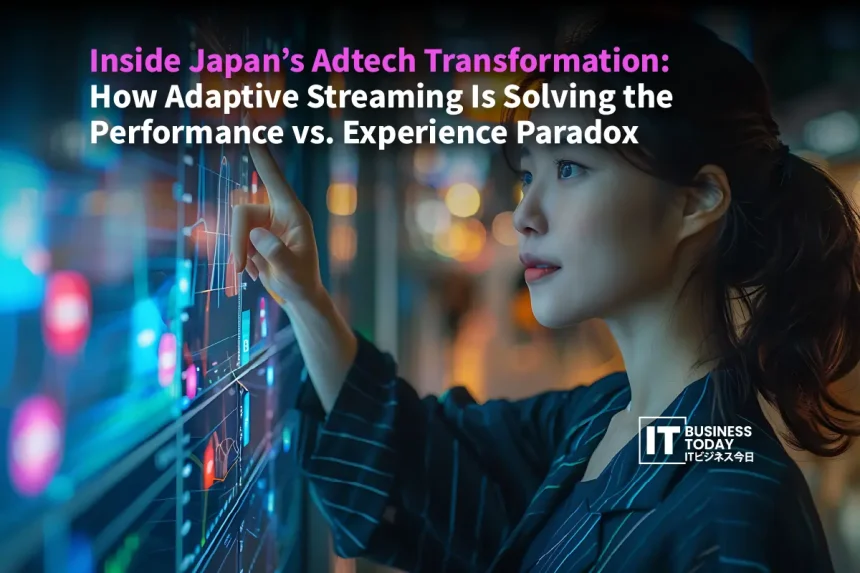何十年もの間、日本は伝統的な広告に大きく依存してきました。テレビ、新聞、バナー、それがマーケターの知る世界でした。デジタルは存在していましたが、その動きは緩やかでした。オンライン動画はニッチで、モバイル・ファーストのキャンペーンは実験的でした。しかし、すべてが変わりました。突然、デジタル動画が急成長を始めたのです。マーケティング担当者は資金を投入し、視聴者はあらゆる場所のスクリーンで視聴するようになり、もはや古いルールは通用しなくなりました。.
これは現実的な問題を引き起こしました。広告主は、大きくて没入感のある動画体験を望んでいます。彼らが求めるのは、注目度、インパクト、心に残るストーリーテリング。視聴者はスピードを求めます。視聴者は、動画が即座に開始され、スムーズにロードされ、データを消費しないことを望んでいます。従来の方法では、その両方を満たすことはできません。高画質では遅くなります。高速配信は体験を殺します。.
アダプティブ・ストリーミングがその答えです。アダプティブ・ストリーミングは、接続やデバイスに応じてビデオの画質をその場で調整します。可能な限りスムーズで高解像度の映像を維持します。配信の問題を解決します。日本では、このテクノロジーによって、アドテクノロジーはついに視聴者が望むものを提供し、マーケティング担当者は必要な結果を得ることができるようになりました。新たなグローバルスタンダードを築きつつあります。.
こちらもお読みください: AIとブロックチェーンが次世代のスマート金融エコシステムをどう動かすか
日本市場のデジタル転換点
長い間、日本は古い広告のやり方に固執してきました。テレビ、印刷物、バナー、それが世界でした。デジタルの動きは緩慢で、特にビデオとモバイルはほとんど慎重でした。このテーマは多くの人が議論していましたが、中心的な課題ではありませんでした。ところが突然、すべてが変わりました。市場が急速に動き始めたのです。現在、広告主は多額の資金をデジタルに割り当てており、中でも動画はその中心です。2024年には広告費全体が 7兆6,730億円. .これは前年を5%近く上回っています。インターネット広告だけで3兆6,517億円。これは全広告費のほぼ半分です。最も伸びたのは動画広告。23%増の8,439億円。これは非常に大きい。これは、マーケティング担当者がどこに賭け、視聴者がどこに注目しているかを示しています。.
ストリーミングはもはや脇役ではありません。コネクテッドTVやオンデマンド・ビデオはどこにでもあります。かつてはニッチで、新しい技術に挑戦する一部の人々のものと考えられていました。今や主流です。CTVとVODに関する市場調査は、強力な普及を示しています。人々はテレビでもモバイルでも、どこでも視聴します。視聴者は柔軟性とパーソナライズを期待しています。視聴者は今すぐ、摩擦なく視聴したいのです。従来のテレビ視聴者は、予定された番組を静かに待っていることはほとんどなくなりました。マーケティング担当者は、視聴者が今いる場所で、どのように視聴したいかに応えなければなりません。.
ここからが厄介なところです。高画質のビデオは重い。データが必要です。人々は移動中であっても高速性を求めます。日本には5Gがあるので、スピードは可能です。しかし、ロード時間が遅い、バッファリングがある、ファイルが大きいというのは、いまだに頭痛の種です。一時停止、不具合、視聴者の不満。そのフラストレーションはブランドに直撃します。優れたクリエイティブであればあるほど、配信が悪ければあるほど苦しくなります。これがパラドックスです。マーケターは大きなインパクトを求めます。視聴者はスピードを求めます。そして、テクノロジーはその両方を同時に実現しなければなりません。近道はなく、妥協もなく、ただ正しいことをするのみ。.
パフォーマンスが経験を殺すパラドックス
配信に失敗するときは、激しく失敗します。動画は開始までに時間がかかりすぎ。ページが重く感じるシーンの途中でバッファリングが発生。人々はクリックして離れます。これらの遅いロード、もたつき、遅延は広告主のKPIを直撃します。直帰率は上昇。完了率は低下します。巧みなターゲティングも、プランニングに費やした労力も、突然どうでもよくなります。.
見る側からすれば、もっと悪い。人々はイライラします。一度でも嫌な経験をすると ブランド 痛みや迷惑を感じながら。広告をスキップしたり、プラットフォームを避けたり、あるいは否定的な意見を抱くことさえあります。クリエイティブな仕事、高予算の動画、細部へのこだわり、配信が追いつかなければすべてが無駄になります。そのフラストレーションはあっという間に広がります。日本では口コミが重要です。たった一度の悪い体験が、忠実な顧客を遠ざけることもあるのです。.
そして、問題は大きくなる一方です。動画は爆発的に増加しています。日本におけるデジタル動画広告費は、2025年には53億8000万ドルに達すると予測されています。コネクテッドTVも急成長しており、その広告費は 6億2,423万ドル 米ドル。つまり、より多くの動画、より多くのキャンペーン、より多くのパラドックスがヒットする機会を意味します。パフォーマンスは、もはや広告主が見て見ぬふりをすることができないものです。リスクは最上位レベルにあります。たった1ミリ秒の遅れでも、エンゲージメントと収益の両方を失う可能性が大きいのです。市場は成長し、視聴者はより多くのことを期待しており、品質とスピードの両方を提供する競争はあまりにも激しいのです。.
アダプティブ・ストリーミングと技術的・体験的ソリューション

アダプティブ・ストリーミングは、単なる技術的なバズワードではありません。むしろ、接続、デバイス、場所に関係なくビデオを再生可能にするアプローチです。システムは視聴者のネットワークとデバイスを常にリアルタイムでチェックします。そして、ビデオの品質とビットレートをその場で調整します。接続が強力であれば、高画質、あるいは4Kをプッシュします。接続が低下すれば、自動的に縮小します。視聴者は、一時停止やバッファリングがほとんどなく、シームレスな体験ができます。これはファイルの縮小でもショートカットでもありません。適切な瞬間に適切なビデオを配信する方法なのです。.
最大の利点はパフォーマンスです。動画がより速く開始され、ストールすることはほとんどありません。一度に送信されるのは必要最小限のファイルセグメントのみです。これにより、サーバーの負荷が軽減され、視聴者を待たせることがなくなります。注意力は短いので、開始時間の節約は1秒でも重要です。バッファリングが少ないということは、フラストレーションが少ないということでもあります。その上、アダプティブ・ストリーミングはデータ効率に優れています。パブリッシャーは配信にかける費用を削減でき、視聴者はデータ使用量を削減できます。日本のようなモバイル・ファーストの市場では、これは非常に重要なことです。人々は、携帯電話、タブレット、スマートテレビなど、あらゆる場所で視聴しています。.
同時に、経験が犠牲になることはありません。可能な限り高画質の映像をお届けします。ユーザーはシャープな画像、クリアな音声、スムーズな再生を得ることができます。クリエイティブな仕事、デザイン、アニメーション、ストーリーテリングの努力は、実際に意図したとおりに視聴者に届きます。これは広告主や代理店にとって重要なことです。例えば、博報堂はクリエイティブ・プラットフォームへの統合を進めています。2025年6月のKPIデータでは、2023年から2025年までのエンゲージメントとアウトプットのトレンドが示されています。また 8ゴールド キャンペーン・アジア・パシフィック・エージェンシー・オブ・ザ・イヤー2024」賞を受賞しました。これは、クリエイティブの質が中心であり、アダプティブ・ストリーミングがそれを無駄にしないことを示しています。.
つまり、アダプティブ・ストリーミングは、最新のビデオを支える配管なのです。パフォーマンスの問題を解決し、視聴体験を維持します。視聴者が望むものを提供し、マーケティング担当者が必要とするインパクトを与えます。妥協することなく、高解像度の動画を可能にします。日本のように急速に成長する市場では、もはやオプションではありません。キャンペーンが成功するか失敗するかの分かれ目です。.
より広い意味合いと日本のアドテクノロジーの未来

アダプティブ・ストリーミングが日本の仕組みを変えつつあります。グローバルなアドテク企業が進出し、地元企業と手を組んでいます。これは日本だけのことではありません。どこでも起きていることなのです。例えば、Seen Thisは日本に進出しています。これは エコシステム フォワード。これは、アダプティブ・ストリーミングが世界的なベストプラクティスになりつつあることを証明しています。同時に、規制当局も注目しています。経済産業省は、Google、Meta、Yahoo Japan、LINEのような大手プラットフォームを調査しました。経産省は、Google、Meta、Yahoo Japan、LINEのような大手プラットフォームを調査し、TFDPAの下で、どれだけ公正で透明性があるかをチェックしました。監視は2025年まで続きます。プラットフォームはルールに従う必要があります。それがマーケターや視聴者がシステムを信頼する理由になります。.
他にも利点があります。アダプティブ・ストリーミングは、ビデオをより速く開始し、バッファリングを止めるだけではありません。データ使用量も少なくなります。適切な量のビデオだけが送信されます。これにより、エネルギーと帯域幅を節約できます。キャンペーンのコストが削減され、持続可能性が高まります。データ転送量が少ないということは、エネルギーの無駄が少ないということです。企業や顧客が環境に配慮する世界では、これは大きな違いです。.
将来的には、アダプティブ・ストリーミングは始まりに過ぎません。すべての動画コンテンツのための配管です。次のステップはスマート・クリエイティブです。AIは、人々がどの動画を、いつ、どのデバイスで見るかを決めることができます。これにより、キャンペーンはより適切で効果的なものになります。アダプティブ・ストリーミングとAI主導の組み合わせが パーソナル化 は、日本のアドテクノロジーの未来を形作るもの。速い。高品質。関連性。それを正しく理解した者が市場を制するでしょう。そうでないものは後塵を拝するでしょう。.
2つのEsの統合
日本のアドテクが直面する現実問題。広告主はインパクトのある動画を求めます。視聴者が求めるのは、速くてスムーズな映像。一方が犠牲になることがあまりにも多いのです。これがパラドックスです。アダプティブ・ストリーミングがその答えです。視聴者を待たせることなく、高品質の動画を提供します。視聴者の関心を引きつけ、ブランドを効果的に保ちます。これは単なる技術的解決策ではありません。これはビジネスの動きです。アダプティブ・ストリーミングを採用する企業は、スピード、品質、関連性を一度に手に入れることができます。日本のアドテクノロジーは、かつてないほど動画が優位に立ち、信頼を築き、成果を上げるための舞台を整えつつあります。.







